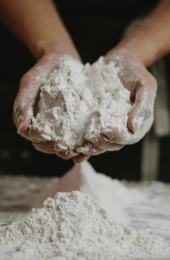
Raw flour is just that. It is raw. To be consumed safely, baking or cooking it is a must. There are some misconceptions or myths surrounding raw flour that could lead to foodborne illness. Here are a few.
- White flour is safer than whole wheat flour. During milling of wheat to making white flour, the bran is removed. This may reduce bacterial load by one log, which is not significant enough to be consumed raw.
- Bleached vs. Unbleached flour. The bleaching process of flour has no effect on the overall safety. It only whitens the color of flour and is still raw flour.
- Heating the flour in the oven or microwave. This is still not a proven step to heat treat flour at home before it is used. Flour is a low moisture food, and some bacteria can survive. Oven or microwave heating may be uneven or could catch the flour on fire.
Sources: Ardent Mills and North American Millers’ Association (Conference on Food Safety Education, 2023)